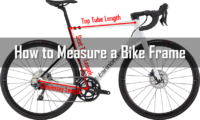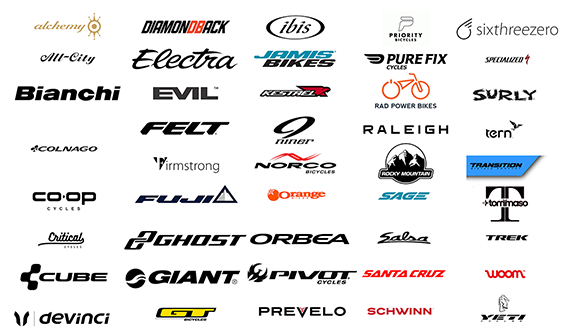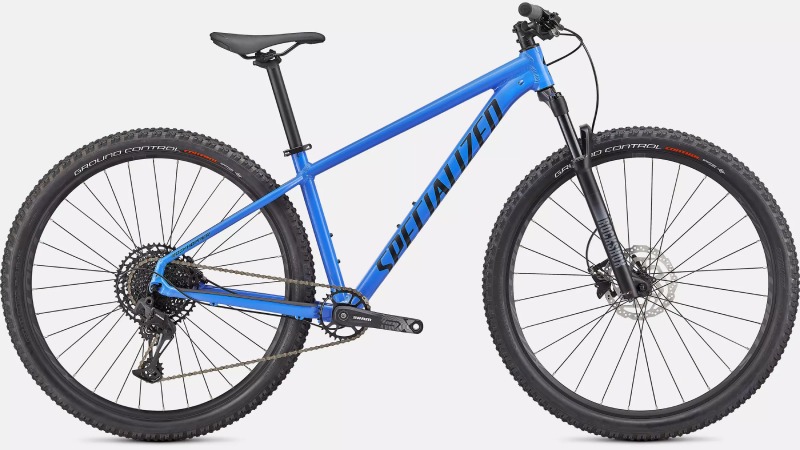
Do you need a hand choosing the right mountain bike?
In this mountain bike buying guide, we will tell you all you need to know in order to find the best bike for you!
Throughout this step-by-step guide, we will ask you multiple questions that will help decide what bikes are suitable for you. You’ll find important details that you must know when it comes to buying a mountain bike. We will try to do all of this without making it too long!
Let’s begin!
/ Overview / Buying Guide / Sizing / Types / Reviews /
Consider Your Riding Preferences
The grand question is, what type of rider are you (or want to be)? There are basically four different so-called mountain bike rider types that we like to use:
- Beginner
- Recreational
- Enthusiast
- Expert
Please keep in mind, these four categories have been made by us to help you choose the right bike in this mountain bicycle buying guide. There are no universal terms used to divide riders into different groups. The purpose of our groups is to give you an overview and help riders to choose the most suitable class for themselves.
Choose the Right Mountain Bike Type
What type is best for you –
XC, Trail, FS?

Once you’ve figured out your riding preferences, it is time to decide on what type of bike you want or need.
There are 3 categories of mountain bikes on the market:
- Hardtails: Suspension on the front. The front suspension is needed to absorb bumps on the trails. Provides a very efficient ride.
- Full Suspension Bikes: Suspension on front and rear. Dual suspension gives you a smoother ride but adds extra weight.
- Rigid Bikes: Rigid mountain bikes have no suspension at all. Not as common anymore. Mainly ridden just for fun.
Each of those will also divide into different mountain bike types. Each type will perform best under the specific discipline it is designed for. Different types of bikes will have differently styled frames, suspension, components, and more. The mountain bike types are listed below:

- XC / Cross Country Bike: Designed for speed. You want to buy this bike when you want to ride with efficiency over most trails.
- Trail & All-mountain bike: Designed to go basically everywhere. Some say trail bikes are just amped-up XC bikes. These bikes are built to absorb rough terrain but also pedal well. Look for one if you want to ride trails that are a little bit rough for XC bikes.
- Enduro bike – Pretty similar to Trail bike but they are more oriented to go downhill (thanks to more suspension). If you like rough up and down trails, then choose an enduro bike.
- Downhill bike – These bikes are designed to be reliable and strong. Look for this long travel bike when you want to ride steep downhills and gnarly terrain.
- Fat bike – Designed with ultra-wide tires so they can be ridden on snow, sand, and deep mud. Fat bikes can take you anywhere but are not as nimble as regular bikes.
- Gravel bike – For those who’d like to keep the speed of a road bike and the capability of a mountain bike
Mountain Bike Suspension Travel Guide
-
80-100mm (XC)
Trail or XC bikes, generally hardtail.
Steep head tube and seat tube angles.
-
110-130mm (Short Travel)
Climbs / descends. Hardtail and full-suspension bikes. Slack head tube for fast downhill riding, and steep seat tube for easier climbing
-
130-150mm (Mid travel)
Climbs / descends. Full-suspension mountain bikes for rough terrains. A long wheelbase and slack head tube angles.
-
150-170mm (Enduro/Long-travel)
Second most rugged bike for the most demanding terrains.
-
170-200mm+ (Gravity/Downhill)
High speeds and the toughest of terrains to ride down to.
Pick the Right Size
There are two main sizes to take into consideration when choosing a bike – frame size and wheel size. The two sizes are often mixed up and can cause some confusion.
Here we will make everything clear. That is the purpose of this mountain bike buyer’s guide after all!
Wheel size
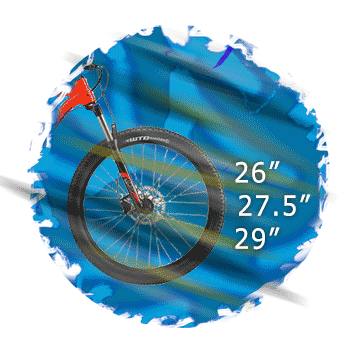
Wheel size plays a huge role in the performance of mountain bikes. The reason behind this is pure physics – higher diameter wheels roll faster over obstacles, where wheels with a smaller diameter react faster. Here is where you get to decide what you care about!
Let’s give you a quick overview of bike wheel sizes:
- 26” was the wheel size standard for decades. When mountain bikes first rolled out, almost all of them featured 26” wheels.
Consider 26” wheels if you are on the shorter size or buying a bike for dirt jumping. - 27.5” wheels are the in-between size and the sweet spot for many riders. They were designed to roll better than 26” wheels but also feel more agile than 29” wheels.
This makes them great on all types of mountain bikes! - 29” wheels are found on most XC bikes today, and are slowly making their way into other disciplines (even DH!). 29” wheels weigh more than the smaller sizes, but thanks to bigger diameter, obstacles are easier to handle.
29” wheels are for riders who care about a fast and efficient ride.
There are also plus-size tires. Plus-sized tires are extra-wide tires (3 or 4 inches wide). They feature superior grip over regular tires however lack the lively feeling that normal-sized tires offer.
Fat bikes make use of extra-wide 26” wheels and tires (wider than plus tires).
Frame Size
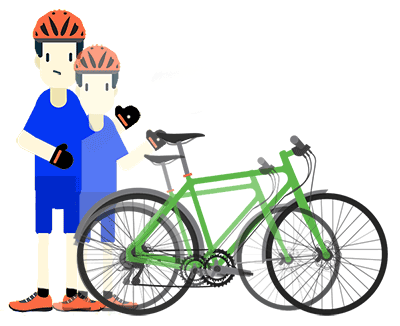
Typically the main disadvantage of buying a bike online is that you can’t try it out yourself. That’s something that many mountain bike guides don’t mention.
However, every manufacturer (who wants to sell their bikes) makes correct and easy-to-read bike sizing graphs for each model that they offer. This makes up for not being able to try it out for yourself before you buy it.
The manufacturers also state geometry such as the head tube angle. With all of this information. It is quite easy to pick the correct size for you. To help you, even more, check out the chart below for a rough sizing guide.
Bike Fit
To adjust your riding position, you may need to move the saddle, or even buy a different stem or handlebars. These are examples of typical adjustments that most experienced cyclists make. If you are just a beginner, try different set-ups until you find out what is comfortable for you.
How to Measure a Bike Frame — Our Easy-to-Follow Guide
If you can’t decide between two sizes and are somewhere between on the sizing guides, we suggest that you choose the bigger frame. This is because it is easier to make a large bike feel smaller than it is to make a small bike feel larger.
Where to Buy MTBs?
Whether you are looking at bikes online, or in local bike shops, you want to look for a good, reliable brand. There are some brands that only sell online (Diamondback for example), and some that sell online and in bike shops. At the moment we don’t know any brands that you can’t find online somewhere. If you happen to know one, tell us!
As you just saw, there are plenty of manufacturers, and this was just a list of 23! There are many more! All of the brands on this list are 100% trusted by us. It is crucial to know which bikes are worth buying and which ones aren’t
We already talked a bit about bike shops on this mountain bike buying guide, so now it’s time to compare buying in a shop vs. buying online.
It is the 21st century. We order many different things online including food, everyday items, and many services.
Frame Materials
Here is where we get to tell you all about the different frame materials used to make mountain bikes. Technology is always improving, but bike frame materials have stayed pretty consistent over the years.
Aluminum
This is the most popular mountain bike frame material. Alloy is relatively cheap, corrosion-resistant, and pretty lightweight (especially the widely spread 6061, 6063, or 7005 alloy). Most often a bike will be 6061 aluminum.
Steel
This material is much denser than aluminum. However, it is also more expensive to mass-produce. Steel frames can be made out of smaller-diameter, and thinner-walled tubes because of steel’s strength. Firstly this means some frames might look slightly different than alloy ones, it also means the frames will probably be heavier.
Carbon
This is a composite material made out of layers of carbon weave. The biggest advantage of carbon is that the material is much lighter than alloy and steel. Carbon is also extremely strong. Its downside, however, is that it tends to crack rather than dent like aluminum. This means that once you crack your frame, it is no longer safe to ride. Most of the mountain bike buying guides will focus mainly on carbons.
Titanium
Titanium frames are not very popular thanks to their cost. The biggest advantage they offer is extra high durability. However, thanks to the other three materials listed above, not many frames today are made of titanium.
To wrap it up, well-known manufacturers have built their reputation by making good frames, so don’t worry too much about the quality of the frame material when buying from them.
Components
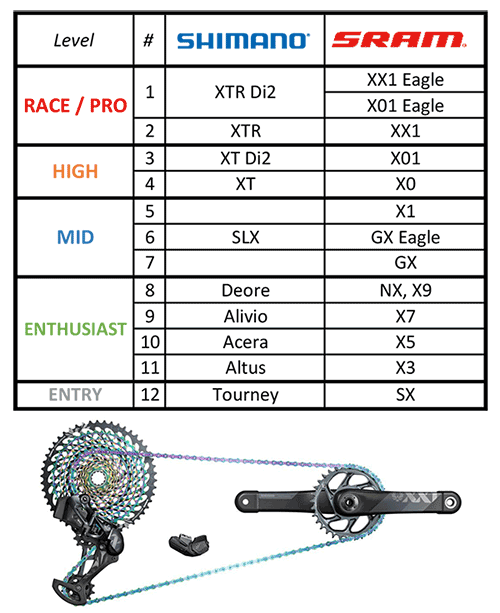
Read more – Groupset Guide
If you already know a lot about bikes as a whole, this might be a good area for you to pay extra attention to. There are hundreds of components out there to choose from. The quality of an overall bike will be decided by the components that the frame is outfitted with.
There are about 104 different bicycle parts – check out the List of Bicycle parts on Wikipedia.
The main manufacturers for components like derailleurs, chainrings, cassettes, cranks, and shifters are made by Shimano & SRAM.
Neither one is better than the other, but each company offers a range starting from entry-level all the way up to pro-level components.
Men’s vs. Women’s MTBs
Men’s, women’s, unisex mountain bikes – what’s the difference in geometry?
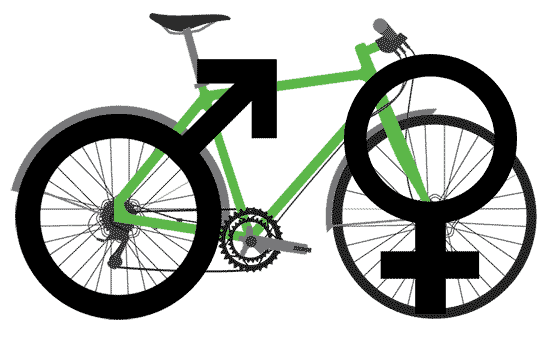
There are women’s specific mountain bike brands such as Liv-Cycling and Juliana. The main difference in geometry is a shorter reach (shorter top tube) and the saddle. Also the grips are slightly smaller in size.
Bottom Line
Although this post needs an update, we hope this mountain bike buying guide opened your eyes and answered some of your questions as well.
Figure out what your needs are, and then start looking for a bike. You’ll find a great bike that suits your budget with the help of this website!
How much you should pay for your mountain bike?
& what to expect
- Mountain bikes for $1,000 > A selection of entry-mid aluminum hardtail models.
- Mountain bikes for $1,500 – A mid-range hardtail bikes with all the bells and whistles.
- Mountain bikes for $2,000 – A good quality trail mountain bike, carbon frames starting to come along.
- Mountain bikes for $2,500 – Entry full-suspension trail mountain bikes, carbon hardtail mountain bikes.
- Mountain bikes for $3,000 > Variation of entry-mid range full-suspension bikes.
- Mountain bikes for $3,500 – The widest option of bikes to choose from.

